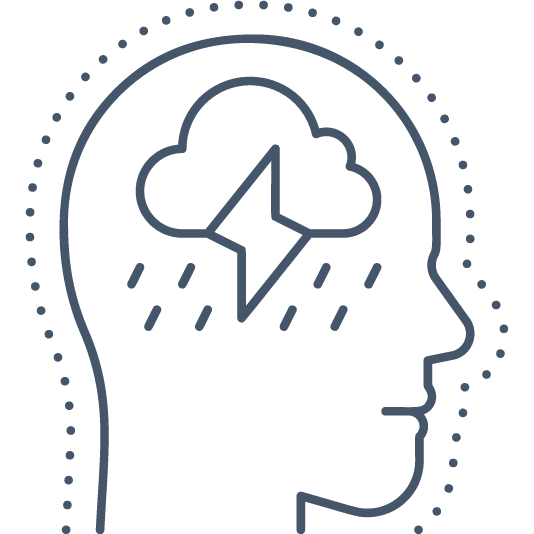Anxiety Disorders
There are markers of anxiety in the brain. In the next video you will see how we can detect “brain hyperactivity” in an anxious person by measuring certain frequencies. In addition, certain regions of the brain (such as hyperactive amygdala) may play an important role in the activation of the nervous system and therefore anxiety. When we do an evaluation in our clinics, all of these markers are measured by doing a quantitative electroencephalogram (qEEG)
During an assessment in our clinics, you first meet a psychologist. He or she will be able to fully understand your situation, your main difficulties, and your goals.
Afterwards, a medical electrophysiology technologist will measure your brain activity using a qEEG. We will analyze the different markers of anxiety and you will receive a report in which you will see images of your brain as well as what should be trained in neurofeedback in order to reduce anxiety.
Although the role of the amygdala is seen as very important in anxiety, current studies in Neurofeedback reveal that 6 other brain regions are also involved at this level. During the evaluation, we measure the level of activity of each of these regions using the qEEG to check if their level of activity is within the norms. Subsequently, using the latest generation of Neurofeedback equipment, we can simultaneously train the different regions known to play a role in the management of anxiety. Training the communication between each of these regions has been shown to be equally as important.
- Decreased anxiety
- Improved sleep
- Better control of emotions
- Fewer panic attacks
- Improved mood
Neurofeedback is currently rated as a Level 5 of 5 intervention for anxiety disorders according to the “Evidence-based Practice in Neurofeedback and Biofeedback 2023” reference guide. In general, clients perceive a decrease in their anxiety after 5 or 7 sessions, but usually continue a dozen more sessions with this protocol in order to reach significant levels of improvement.
It has been shown that the benefits obtained with Neurofeedback are usually long-lasting and even with optimized brain capabilities, they continue to improve in the following months until the end of the Neurofeedback workouts.

While anxiety disorders can vary greatly, each presents particular symptoms. This condition significantly impacts both your emotional and physical well-being.
Separation Anxiety Disorder
This disorder is characterized by crises occurring during separation. Children become fixated on reunions and may develop symptoms such as headaches or stomachaches when they occur.
Generalized Anxiety Disorder
Accompanied by symptoms like restlessness, nervousness, fatigue, muscle tension, and sleep disturbances, generalized anxiety disorder is induced by excessive worries related to everyday events or activities. For example, work responsibilities, family health, etc. Individuals with generalized anxiety have difficulty controlling their worries and preventing their distressing thoughts from interfering with daily activities.
Specific Phobias
Specific phobias are pervasive anxiety disorders. The most common include fear of animals, heights, blood, claustrophobia, etc. A person with a particular phobia experiences marked anxiety in response to the feared situation and tends to avoid such situations.
Social Anxiety Disorder
Presented as a fear of certain social situations, this anxiety disorder makes the affected person apprehensive, worrying about their every move in a social context. Among the conditions that can trigger social anxiety disorder are public speaking, meeting strangers, paying for items in stores, etc.
Panic Disorder
A panic attack involves the onset of discomfort accompanied by physical symptoms such as shortness of breath, nausea, trembling, hot flashes, a lump in the throat, etc. Additionally, people often feel like they are having a heart attack or are about to die. Panic disorder manifests through repetitive and unpredictable panic attacks (unexpected and spontaneous).
Agoraphobia
An anxiety disorder characterized by fear in certain places and situations that the person perceives as difficult to escape, such as open spaces and public transportation. This condition is often associated with panic disorder. Agoraphobia can lead to fear of leaving home, standing in line, or sitting in a classroom. Agoraphobia can develop in response to panic attacks.
Diagnostic Assessment
A physician or psychologist should conduct a diagnostic assessment to ensure a proper understanding of your symptoms. During the consultation with the healthcare professional, the child or adult should discuss their difficulties, the intensity of their experiences, and their frequency. They should also explain how these symptoms affect their daily lives.
The physician or psychologist investigates the causes and risk factors during the session. This assessment, essential for making the correct diagnosis, is necessary to identify the anxiety disorder you are experiencing and to inform you about your condition and its management.
At Neuroperforma, we are qualified to evaluate your symptoms and determine your recovery goals. Our specialists can measure your brain activity using quantitative electroencephalography (qEEG). Some dysfunctions in brain activity are associated with anxiety symptoms, and this will enable us to offer solutions to improve your condition with neurofeedback. Note that Neuroperforma does not conduct diagnostic examinations.
The most common treatment is medication and psychotherapy. In this case, you have prescribed medication and undergo cognitive-behavioral therapy.
There are several, such as generalized anxiety disorder, panic disorder, specific phobias, or agoraphobia. Social anxiety disorder and separation anxiety disorder may also be among other anxiety disorders.
Among the best options are breathing exercises and engaging in activities such as meditation, yoga, or sports. You can also visit our clinics for neurofeedback training.
Stress management improves quality of life and physical health, helps regulate mood, and provides patients with a sense of peace.
Anxiety disorders can disrupt life in familial, educational, or professional settings, as well as socially.
Anxiety is the anticipation of a future, sometimes imagined threat accompanied by unpleasant feelings and sensations. On the other hand, stress is a normal physiological response induced by the body when disturbed by a stressor or real danger.


